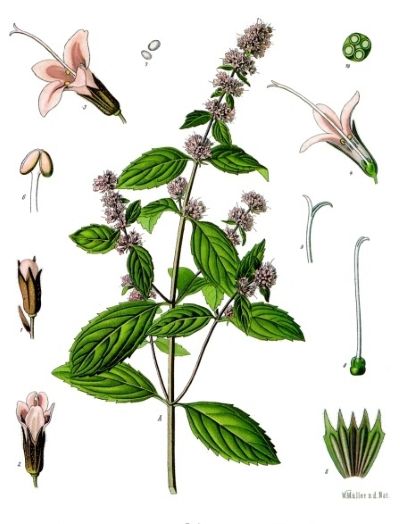Peppermint
Peppermint
Mentha piperita L.
Family Lamiaceae — Mint Family
Peppermint Description
Peppermint is a perennial herbaceous plant, 30–100 cm tall, with a quadrangular stem and a rhizome that produces shoots. The leaves are opposite, lanceolate, 3–8 cm long, dark green, with a serrated margin. The flowers are small, purple, 3–5 mm, gathered in spike-like inflorescences. Fruits — nutlets, rarely formed. Popular varieties include ‘Mitcham’, ‘Black Peppermint’, and ‘White Peppermint’. Flowering occurs from July to August, with rare fruiting in September.
Habitat and Ecology of Peppermint
Peppermint is a hybrid of Mentha aquatica and Mentha spicata, cultivated in Europe, Asia, North America, and Australia. It grows in Russia, Ukraine, Central Asia, in moist meadows, along water bodies, up to 1000 m above sea level. It prefers loose, moist soils (pH 6.0–7.0), partial shade or sun, watering 5–10 l/m² every 7–10 days. It propagates by rhizomes and cuttings. Yield: 1–3 kg/m² of dried leaves. Care: weeding, nitrogen fertilization (10–15 g/m²), protection against aphids and mint flea beetles. Used in landscaping and as a honey plant.
Peppermint Raw Materials
Raw materials: leaves (folia Menthae piperitae), herb (herba Menthae piperitae). Leaves are harvested in June–August before flowering, dried at 30–40 °C (yield 15–20 %). The herb is harvested in July–August, dried at 40 °C (yield 20–25 %). Quality: leaves — green, free of mold; herb — green; moisture <=12 %. Store in airtight containers (leaves: 1 year; herb: 1 year). The smell is minty, the taste is refreshing, slightly pungent.
Chemical Composition of Peppermint
Leaves and herb: essential oil (up to 3 %, menthol 40–60 %), flavonoids, tannins (up to 5 %), organic acids (rosmarinic), vitamin C (up to 30 mg%), carotenoids, minerals (K, Ca, Mg). Caloric content of leaves: 20–30 kcal/100 g (dried).
Action and Application of Peppermint
Peppermint has antispasmodic, calming, anti-inflammatory, antiseptic, and choleretic effects. It is used for headaches, insomnia, gastritis, intestinal spasms, colds, nausea, and gum diseases. Leaves improve digestion, reduce stress, and ease breathing during a runny nose. The herb is used for neuroses and throat inflammations. Peppermint essential oil is effective for migraines and skin irritations.
Precautions for Peppermint Use
Consumption of >5 g/day of dried leaves or >50 ml/day of infusion can cause low blood pressure, drowsiness. Store infusions at 0–5 °C for no longer than 24 hours. Not recommended for children under 3 years. Avoid combining with hypotensive drugs (enhances effect). Essential oil (>5 drops/day) can cause skin irritation, allergies. Long-term use (>4 weeks) requires a break (2 weeks). Carefully check raw materials for pesticides.
Contraindications for Peppermint Use
Allergy to Lamiaceae, hypotension, gastritis with low acidity, gallstone disease, pregnancy, lactation, age under 3 years.
Peppermint Recipes
- Leaf Infusion for Insomnia. Pour 200 ml of boiling water over 5 g of leaves, steep for 20 min, drink 50 ml before bed for 7 days.
- Herb Decoction for Gastritis. Boil 5 g of herb in 200 ml of water for 10 min, drink 50 ml twice a day for 7 days.
- Mouthwash for Gum Inflammation. Pour 100 ml of boiling water over 10 g of leaves, steep for 20 min, rinse mouth twice a day for 5 days.
- Inhalation for Colds. Pour 200 ml of boiling water over 10 g of leaves, inhale steam for 5–10 min, once a day for 3 days.
- Peppermint Tea for Digestion. Steep 1 teaspoon of dried peppermint leaves (or 2-3 fresh leaves) in 200 ml of hot water for 5-10 minutes. Drink after meals to aid digestion.
- Peppermint Oil for Headaches (topical). Dilute 2-3 drops of peppermint essential oil in 1 teaspoon of carrier oil (like jojoba or almond oil). Gently massage onto temples and forehead. Avoid contact with eyes.
Peppermint Cosmetics
Peppermint is used for skin and hair care.
- Mask for Oily Skin. Crush 10 g of leaves, mix with 10 ml of yogurt, apply for 15 min, rinse off, twice a week.
- Toning Lotion. Mix 10 ml of leaf infusion with 10 ml of water, wipe skin, once a day.
- Hair Rinse. Pour 200 ml of boiling water over 10 g of leaves, steep for 20 min, rinse hair, once a week.
- Acne Mask. 10 g of leaves, 10 ml of honey, apply for 15 min, rinse off, twice a week.
Peppermint Culinary Uses
Leaves are used fresh or dried in drinks, desserts, and sauces.
- Peppermint Tea. Pour 200 ml of boiling water over 5 g of fresh or 3 g of dried leaves, steep for 10 min.
- Meat Sauce. 10 g of leaves, 50 ml of yogurt, 5 ml of lemon juice, blend.
- Smoothie. 10 g of leaves, 200 g of fruits, 100 ml of yogurt, blend.
- Dessert Syrup. 20 g of leaves, 100 g of sugar, 100 ml of water, boil for 10 min, strain.
- Mojito Cocktail (non-alcoholic). Muddle a handful of fresh peppermint leaves with lime wedges and a teaspoon of sugar in a glass. Top with crushed ice and sparkling water.
- Chocolate Peppermint Cookies. Add finely chopped fresh peppermint leaves or a few drops of peppermint extract to your favorite chocolate cookie dough before baking.
Tips: Store fresh leaves at 0–5 °C for up to 1 week, dried ones for up to 1 year. Use young leaves for an intense aroma.
Other Properties of Peppermint
Used in ornamental landscaping, as a honey plant, and for room aromatization.




